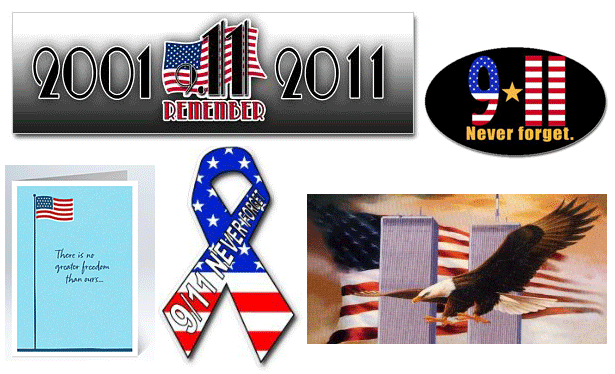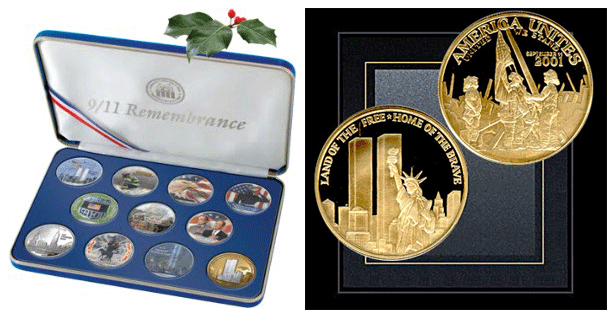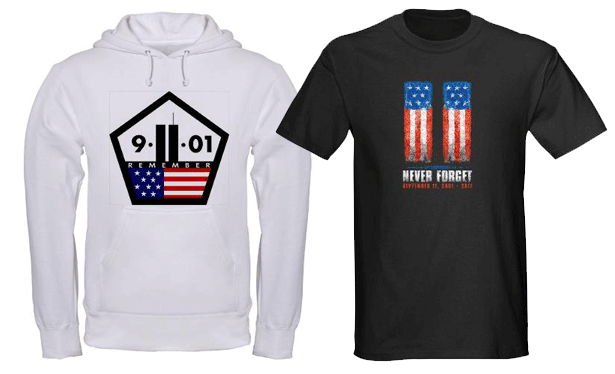 [Editor's note: As we approach the tenth anniversary of the terrorist attacks that took place on 9/11/2001 in New York City and Washington, DC, and the failed attack that resulted in a plane crash in Pennsylvania, we feel that it's worth discussing the role designers have in relation to companies attempting to profit from tragedies such as this.]
I remember the morning of the attack as if it was yesterday. It almost was. I was walking into work at a well-known greeting card company when a coworker asked if I had heard that a plane hit the World Trade Center.
I joked that some idiot pilot in a private two-seater probably got too close and smashed into the side, shattering some glass and causing extreme embarrassment.
I had worked in the trade center south building. It was a massive structure and the engineering was considerable. The toilets on the 85th floor would slosh around in high winds because the building was engineered to sway with the wind and not to break.
When I entered the building and stepped into my department, everyone was gathered around a small TV that a coworker kept in their desk. My short moment of head-shaking mirth turned into horror. Not only was there a gaping hole in the south tower—it was at the point of the office and people I had come to know.
Time stood still as I watched as minutes and hours passed. Another plane smashed into the north tower. Flames and smoke. Fear, running, crying people—death. Then someone next to me screamed. "OH MY GOD! WE COULD BE NEXT!"
We all turned at looked at her in disbelief. "Well," she said with indignation, "we ARE an American icon!"
"Yes," I murmured back with a cold stare. "I'm sure that after the trade center and Pentagon, a greeting card company will be next on the list."
She ran off in tears. I don't think it was embarrassment. Who could really know what was going to happen next? She was scared and confused. We all were. She was also convinced of the importance of the company over those who we witnessed suffering and dying. It was an attitude I would be witness to often, as the months went by.
[Editor's note: As we approach the tenth anniversary of the terrorist attacks that took place on 9/11/2001 in New York City and Washington, DC, and the failed attack that resulted in a plane crash in Pennsylvania, we feel that it's worth discussing the role designers have in relation to companies attempting to profit from tragedies such as this.]
I remember the morning of the attack as if it was yesterday. It almost was. I was walking into work at a well-known greeting card company when a coworker asked if I had heard that a plane hit the World Trade Center.
I joked that some idiot pilot in a private two-seater probably got too close and smashed into the side, shattering some glass and causing extreme embarrassment.
I had worked in the trade center south building. It was a massive structure and the engineering was considerable. The toilets on the 85th floor would slosh around in high winds because the building was engineered to sway with the wind and not to break.
When I entered the building and stepped into my department, everyone was gathered around a small TV that a coworker kept in their desk. My short moment of head-shaking mirth turned into horror. Not only was there a gaping hole in the south tower—it was at the point of the office and people I had come to know.
Time stood still as I watched as minutes and hours passed. Another plane smashed into the north tower. Flames and smoke. Fear, running, crying people—death. Then someone next to me screamed. "OH MY GOD! WE COULD BE NEXT!"
We all turned at looked at her in disbelief. "Well," she said with indignation, "we ARE an American icon!"
"Yes," I murmured back with a cold stare. "I'm sure that after the trade center and Pentagon, a greeting card company will be next on the list."
She ran off in tears. I don't think it was embarrassment. Who could really know what was going to happen next? She was scared and confused. We all were. She was also convinced of the importance of the company over those who we witnessed suffering and dying. It was an attitude I would be witness to often, as the months went by.
What and who is important in life?
The panicked woman who thought that such planned terror attacks, meant to destroy the American financial system, the military control and, in the case of the flight that crashed in a field in Pennsylvania, the political lead of the American people, wasn’t really different from the heads of the greeting card company when she thought that by destroying the place where birthday cards were produced, the American people would be completely demoralized without cards with Hello Kitty, wide-eyed kittens, or watercolor baskets of flowers arriving on people’s special days. It wasn’t so much the ridiculousness of that as it was the utter audacity that she, and eventually product producers, would hold themselves above the tragedy and turn it into a way to make a buck. It didn’t take long for the dark side of tragedy to raise the ugly head of commercialism. A self-seeking creative leader also exhibited the same self-importance of the company and sent out a message to the creative staff announcing a “9/11 Memorial Exhibit” that would be done by volunteers and would “tour the country.” Usually these calls for “volunteers” meant corporate heads were taking note of who volunteered and who didn’t. The head of creative services had an odd vision for the 1,000-plus employee design department and had posters placed all over the company declaring, “Our Vision: To Be A World Class Design Company.” To this end, “volunteer opportunities” arose quickly for the not so subtle purpose of public relations. In fact, the PR purpose was usually announced quite proudly. While the staff of extremely talented designers was insulted by the assertion that somehow they didn’t measure up in the minds of executives who enjoyed high salaries due to sales of products designed by the corporate flunkies, we followed the calls for us to “volunteer,” always followed by the stern warning it was to be “on (our) own time and at (our) own expense.” However, this call to build on the suffering of those whose remains still lay in the rubble went unanswered. There were some secondary rumbles for “volunteers” but they faded away before people started talking to local newspapers and TV stations about this absurd travesty.Patriot’s Day: Remember and consume!
As with many companies, the products started being planned and produced for “remember 9/11” and junk labeled with the words, “freedom,” “never forget” and the last words of a doomed man on one of the flights, “let’s roll!” Even today, ten years later, we see 9/11 products everywhere: Trade Tower coins, postcards, T-shirts, commemorative plates, statuettes, thermometers, made-for TV movies, etc., etc. etc. Anything that will make someone money while the shattered and vaporized bodies of a few thousand victims lay in landfills and line the bottoms of New York City sewers.

 It isn’t just products. Politicians build their campaigns on the mound of the silenced dead. Campaigns are waged in the name of the victims, laws are changed, and rights denied—and willingly surrendered. If the day is made into a national holiday, it will be thought of as a day off work and school, as with Memorial Day, spent in malls buying these products and “Freedom Beer” to consume at the beach or park.
People may remember but they often don’t truly care. If they did, they wouldn’t purchase these products produced on the blood of those who perished. They do and when a special about the tragedy airs on TV tomorrow, most people will turn the channel and watch an infomercial for some cooking device that makes dinner for four in just five minutes or be mesmerized by some dancing, D-list celebrities.
It isn’t just products. Politicians build their campaigns on the mound of the silenced dead. Campaigns are waged in the name of the victims, laws are changed, and rights denied—and willingly surrendered. If the day is made into a national holiday, it will be thought of as a day off work and school, as with Memorial Day, spent in malls buying these products and “Freedom Beer” to consume at the beach or park.
People may remember but they often don’t truly care. If they did, they wouldn’t purchase these products produced on the blood of those who perished. They do and when a special about the tragedy airs on TV tomorrow, most people will turn the channel and watch an infomercial for some cooking device that makes dinner for four in just five minutes or be mesmerized by some dancing, D-list celebrities.
Do YOU care?
The one thing all of these products have in common is the idea may start in the diseased mind of some shallow, callous individual, but eventually it falls to a designer to carry out the heinous initiative. What can one do when ordered to create a 9/11 memorial product? Unfortunately, there’s not much one can do aside from quitting and allowing someone else to step in and sell out for a buck. You can voice your displeasure when a “patriot product” is being planned but you will only be considered “not a team player” and threatened with, “we can find someone else who will design it AND work overtime for no extra pay!” The reality of the living is we need money to survive, and often have few choices or lack the ability to stand up against this sort of commercialism. Consumers are just as culpable. If no one bought these items, there would be no call to produce them. It’s a vicious circle and, as designers, we are caught between supply and demand. Unfortunately, commercialization and using tragedy for gain is not new to society. I was once sent to a client by a temporary placement agent. It was my first assignment with them, which is the test if one becomes a regular or if there are no further calls. I wanted to do a stellar job and showed up on time and willing to sell my soul, if necessary. It was. The client wanted his material redesigned so the letter from a female psychic would have all names and gender specific references changed to a male character who didn’t exist. The man who owned this sleazy business was quite proud of how he made a fortune off sending these psychic letters to senior citizens, tempting them with “individual psychic reports” and “good luck moon charms.” He showed me boxes of trinkets made in China and stacks of “psychic reports,” each one the same. Each one promising lottery wins, good luck, money, love and happiness if more products and “reports” were purchased. It was quite a scam and I was now part of it. When lunchtime arrived, I excused myself and went outside to call the agent. I informed her of what was going on and asked if I could leave. She asked me to finish the assignment. Naturally, the client asked if I would do further work for him without going through the agent so he could save some money and I could “make a few extra bucks.” I left at the end of the day and called the agent to voice my disgust and displeasure. I didn’t mention that the client wanted me to forsake my contract with the agent but said I would not go back and they should know everything that happened. I found out later that the agent kept calling him to see if he needed any further work. I never worked for that agent again. I didn’t want to think of how many innocent people got duped by this man’s psychic scam. A year later, I went back to the same building for a different client and noticed the scammer’s office was empty. The custodian said he moved out in the middle of the night, owing the landlord several months of rent. Throughout my career, there have been incidents that stretched my morals. From editors who want vendors to go above and beyond their contracts for the promise of “making it up later” to bosses who told me outright they had no intention of paying a designer or illustrator. Usually it’s just having to bend to the will of design-by-committee and letting the product suffer from being watered down. I usually got myself into trouble by arguing the point. I wasn’t a “team player” or I was not a “company man.” In the long run, I was easily replaced by someone who didn’t care, although even they didn’t last too long. They say “a coward is a brave man with kids and a mortgage.” It’s sadly true.What Can YOU do?
I wish I knew what to say about morals, transgressions, and being trapped by the need to make a living. We all sell out in some way. We bow to corporate will, nod in agreement to our supervisors and collect our paychecks and turn a blind eye, telling ourselves it’s all part of life. It is and there’s no way to sugarcoat it. There is a way to do penance for these daily occurrences. Some may ask God to forgive them and others may take self-affirmation that it doesn’t make a difference. I’d like to believe that there is a karmic scorecard and by doing right where one can—having charity and kindness and holding out a helping hand helps balance our score. It’s up to personal choice and your inner feelings about what you do and what you will leave in your wake. I’ve heard people exclaim that they wanted to become designers to help make the world a better place through design—to make a difference. In a shallow world, gone mad with commercialism, that dream is still possible. It is up to us to take two steps forward for the one step society pushes us backward. We can’t help those who are gone but we can honor their memories by creating something that matters. It may not be what pays us our daily wage. It may be hard to get people to pay attention but it is possible to make a difference, even if it’s our own little corner of the universe. Add the little corners together and we can make a difference—eventually a big difference. Have you been pressured to go against your morals for your job? Have you done something that made a difference? Tell us about it. Tell us how you felt about it.Speider Schneider
Speider Schneider is a former member of The Usual Gang of Idiots at MAD Magazine and has designed products for Disney/Pixar, Warner Bros., Harley-Davidson, ESPN, Mattel, DC and Marvel Comics, Cartoon Network and Nickelodeon among other notable companies. Speider is a former member of the board for the Graphic Artists Guild, co-chair of the GAG Professional Practices Committee and a former board member of the Society of Illustrators. Follow him on Twitter @speider or add him on Google+
Read Next
20 Best New Websites, April 2024
Welcome to our sites of the month for April. With some websites, the details make all the difference, while in others,…
Exciting New Tools for Designers, April 2024
Welcome to our April tools collection. There are no practical jokes here, just practical gadgets, services, and apps to…
14 Top UX Tools for Designers in 2024
User Experience (UX) is one of the most important fields of design, so it should come as no surprise that there are a…
By Simon Sterne
What Negative Effects Does a Bad Website Design Have On My Business?
Consumer expectations for a responsive, immersive, and visually appealing website experience have never been higher. In…
10+ Best Resources & Tools for Web Designers (2024 update)
Is searching for the best web design tools to suit your needs akin to having a recurring bad dream? Does each…
By WDD Staff
3 Essential Design Trends, April 2024
Ready to jump into some amazing new design ideas for Spring? Our roundup has everything from UX to color trends…
How to Plan Your First Successful Website
Planning a new website can be exciting and — if you’re anything like me — a little daunting. Whether you’re an…
By Simon Sterne
15 Best New Fonts, March 2024
Welcome to March’s edition of our roundup of the best new fonts for designers. This month’s compilation includes…
By Ben Moss
LimeWire Developer APIs Herald a New Era of AI Integration
Generative AI is a fascinating technology. Far from the design killer some people feared, it is an empowering and…
By WDD Staff
20 Best New Websites, March 2024
Welcome to our pick of sites for March. This month’s collection tends towards the simple and clean, which goes to show…
Exciting New Tools for Designers, March 2024
The fast-paced world of design never stops turning, and staying ahead of the curve is essential for creatives. As…
Web Tech Trends to Watch in 2024 and Beyond
It hardly seems possible given the radical transformations we’ve seen over the last few decades, but the web design…
By Louise North















